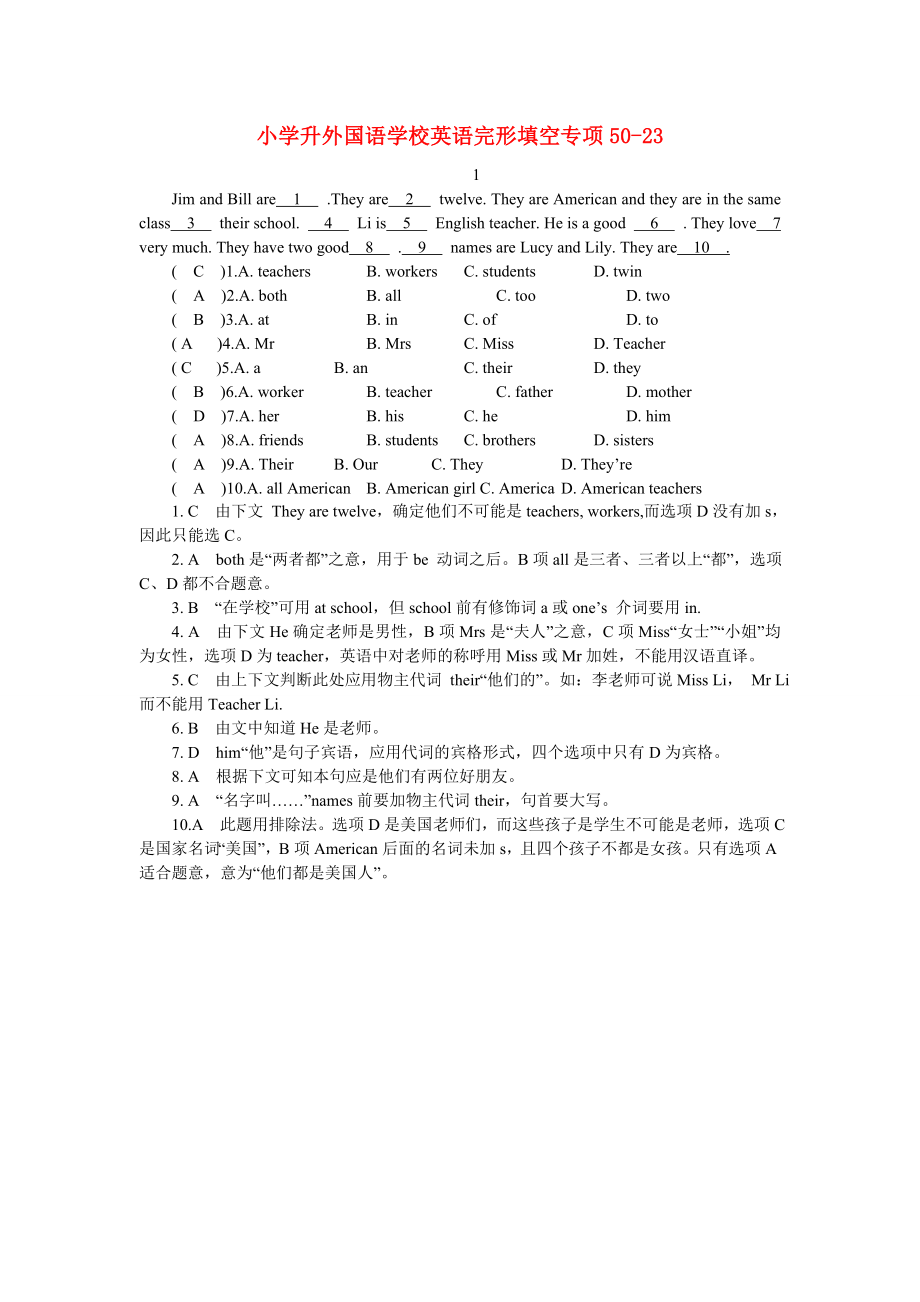《寧夏外國(guó)語(yǔ)學(xué)校小升初英語(yǔ)專(zhuān)項(xiàng)訓(xùn)練 完形填空23》由會(huì)員分享�����,可在線(xiàn)閱讀�����,更多相關(guān)《寧夏外國(guó)語(yǔ)學(xué)校小升初英語(yǔ)專(zhuān)項(xiàng)訓(xùn)練 完形填空23(2頁(yè)珍藏版)》請(qǐng)?jiān)谘b配圖網(wǎng)上搜索�����。
1�����、小學(xué)升外國(guó)語(yǔ)學(xué)校英語(yǔ)完形填空專(zhuān)項(xiàng)50-23
1
Jim and Bill are 1 .They are 2 twelve. They are American and they are in the same class 3 their school. 4 Li is 5 English teacher. He is a good 6 . They love 7 very much. They have two good 8 . 9 names are Lucy and Lily. They are 10 .
( C )
2�����、1.A. teachers B. workers C. students D. twin
( A )2.A. both B. all C. too D. two
( B )3.A. at B. in C. of D. to
( A )4.A. Mr B. Mrs C. Miss D. Teacher
( C )5.A. a B. an C. their D. they
( B )6.A. worker B. teacher C. father D. mother
( D )7.A. her B.
3�����、 his C. he D. him
( A )8.A. friends B. students C. brothers D. sisters
( A )9.A. Their B. Our C. They D. They’re
( A )10.A. all American B. American girl C. America D. American teachers
1. C 由下文 They are twelve�����,確定他們不可能是teachers, workers,而選項(xiàng)D沒(méi)有加s�����,因此只能選C�����。
2. A both是“兩者都”之意�����,用于be
4�����、動(dòng)詞之后�����。B項(xiàng)all是三者�����、三者以上“都”,選項(xiàng)C�����、D都不合題意�����。
3. B “在學(xué)?����!笨捎胊t school�����,但school前有修飾詞a或one’s 介詞要用in.
4. A 由下文He確定老師是男性�����,B項(xiàng)Mrs是“夫人”之意�����,C項(xiàng)Miss“女士”“小姐”均為女性�����,選項(xiàng)D為teacher,英語(yǔ)中對(duì)老師的稱(chēng)呼用Miss或Mr加姓�����,不能用漢語(yǔ)直譯�����。
5. C 由上下文判斷此處應(yīng)用物主代詞 their“他們的”�����。如:李老師可說(shuō)Miss Li�����, Mr Li而不能用Teacher Li.
6. B 由文中知道He是老師�����。
7. D him“他”是句子賓語(yǔ)�����,應(yīng)用代詞的賓格形式�����,四個(gè)選
5�����、項(xiàng)中只有D為賓格�����。
8. A 根據(jù)下文可知本句應(yīng)是他們有兩位好朋友�����。
9. A “名字叫……”names前要加物主代詞their�����,句首要大寫(xiě)�����。
10.A 此題用排除法�����。選項(xiàng)D是美國(guó)老師們,而這些孩子是學(xué)生不可能是老師�����,選項(xiàng)C是國(guó)家名詞“美國(guó)”�����,B項(xiàng)American后面的名詞未加s�����,且四個(gè)孩子不都是女孩�����。只有選項(xiàng)A適合題意�����,意為“他們都是美國(guó)人”�����。
2
This 1 my room. It is a 2 nice room. The windows 3 big and the walls 4 white.
6�����、Near the windows there is a red desk. It is for me. 5 the desk there are some books and 6 pencil- box. 7 the back wall there are some pictures and 8 map of China. There is 9 bed. It is near the door. There is a chair behind the bed. There is a box and a pair of new shoes 10 the b
7�����、ed.
( C )1.A. are B. am C. is D. be
( B )2.A. much B. very C. too D. now
( B )3.A. is B. are C. am D. X
( A )4.A. are B. is C. be D. X
( B )5.A. on B. On C. in D. under
( A )6.A. a B. two C. some D. much
( C )7.A. in B. In C. On
8�����、 D. at
( C )8.A. X B. an C. a D. some
( B )9.A. an B. a C. not D. the
( C )10.A. in B. at C. under D. from
1. C 主語(yǔ)This為單數(shù)�����,系動(dòng)詞用is 與其搭配�����。
2. B very意為“很�����、非常”是程度副詞�����,用來(lái)修飾形容詞或副詞�����。Much作“許多”解�����,修飾不可數(shù)名詞�����。Too表示“也”�����,一般放在肯定句句末�����。 Now意為“現(xiàn)在”不能用來(lái)修飾形容詞�����。
3. B 主語(yǔ)為復(fù)數(shù)�����,系動(dòng)詞用are.
4. A 主語(yǔ)為復(fù)數(shù)�����,系動(dòng)詞用are.
5. B 書(shū)放在書(shū)桌上用介詞on�����,A項(xiàng)沒(méi)有大寫(xiě)�����。
6. A a修飾單數(shù)可數(shù)名詞�����。B項(xiàng)�����、C項(xiàng)均修飾可數(shù)名詞的復(fù)數(shù)形式。Much修飾不可數(shù)名詞�����。
7. C 表示畫(huà)在墻上的用介詞on
8. C 固定詞組a map of China意為“一幅中國(guó)地圖”�����。
9. B a用在發(fā)輔音音素的開(kāi)頭的單詞前�����。
10.C 表示鞋子在床下用介詞under.
 寧夏外國(guó)語(yǔ)學(xué)校小升初英語(yǔ)專(zhuān)項(xiàng)訓(xùn)練 完形填空23
寧夏外國(guó)語(yǔ)學(xué)校小升初英語(yǔ)專(zhuān)項(xiàng)訓(xùn)練 完形填空23

